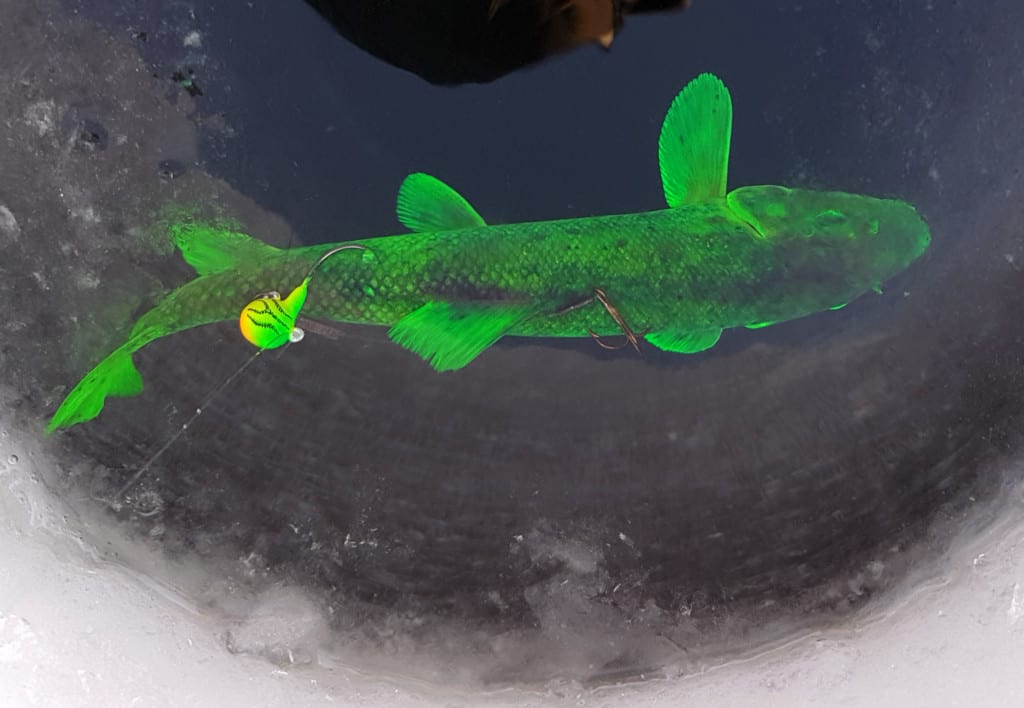By: Tom Armstrong
Cold temperatures and major snowfalls have winter in full force in Northwestern Ontario. As our lakes frozen early the region is covered in a layer of snow and ice. In fact, some anglers were drilling holes as early as November! Almost all area lakes are fishable through the ice. Many are even accessible by truck. Early season can be an exceptional time to ice fish the region and a great time to chase stocked brook trout and walleye.
That’s what’s so great about living near Thunder Bay. Ontario has a plethora of stocked trout lakes, quality lake trout fishing and good walleye fishing, too. Using an array of methods these species are available in countless lakes across the province. Throughout the season I normally chase brook trout, splake, rainbows, walleye, lake trout and other species.

For brook trout I generally use worms and minnows. Tipping a Hopkins spoon with a chunk of worm is hard to resist, but big brookies have a hard time resisting a live minnow just below the ice. When I use minnows through the ice I Fire Dye them chartreuse. Adding colour to these baits can give you an edge. For walleye, live suckers and minnows are a must have. Using Blue and Chartreuse Fire Dye on live minnows can pay dividends, especially in some of the darker water lakes
Dying live minnows/suckers is a quick, efficient process, but needs to be done carefully. Fire Dye needs to be concentrated to ensure the minnows take the dye, but you also need to careful to keep them alive. I dye them in an insulated minnow pail, with a lid and a battery powered aerator. Having the minnows on oxygen is important to keep them healthy and happy when mixed with the dye.

When using Fire Dye mix the water and dye at a 3:1 ratio and let it sit 20-30 minutes. This means one full bottle of Fire Dye and then filling the dye bottle with lake/river water three times. Once the baitfish are in the dye for 30 minutes see how coloured they are. If they’re completely dyed, remove them from the dye and into a pail of fresh water. After dyed they’ll hold the colour all day long. Be careful with Fire Dye. It’s a dye. It will stain hands, clothes and anything else it touches.

West of Thunder Bay, Lac Des Milles Lacs is a popular walleye lake. It’s a productive walleye lake and sustains heavy pressure, but can be finicky. Last winter, my wife and I spent a couple days fishing here while staying in a rental shack from Sugar Shack Rentals. The days prior to us fishing brought poor reports. Neighboring shacks reported one to two walleye and the odd pike each day. I started marking fish right away, but had a hard time catching anything. The fish were sluggish and seemed disinterested in eating.
The bite was slow, at first. However, after I soaked suckers, minnows and small dace in Chartreuse Fire Dye the walleye began to feed. I’m convinced the bright bait spurred a bite, especially since they wouldn’t bite anything else we fished before dying the bait. That afternoon we fished two lines in the hut; one with a plain minnow and the other with Chartreuse Fire Dye minnows. Without exaggerating the dyed minnows out-produced regular minnows 10-1. The dyed minnows in darker water magically convinced these hesitant walleye to bite.

Whether it’s dyed worms for brookies, minnows for walleye or big suckers for lake trout Fire Dye is an effective way to increase your odds in early ice. With a little bit of effort (and slightly dyed fingertips) it’s easy to do. Try this under the ice and you’ll likely catch more fish – like we did.

Editor’s Note: Outdoor writer Tom Armstrong resides in Thunder Bay. Hunting and fishing is his passion. To follow Armstrong’s adventures please visit http://www.tomarmstrongoutdoors.com.






